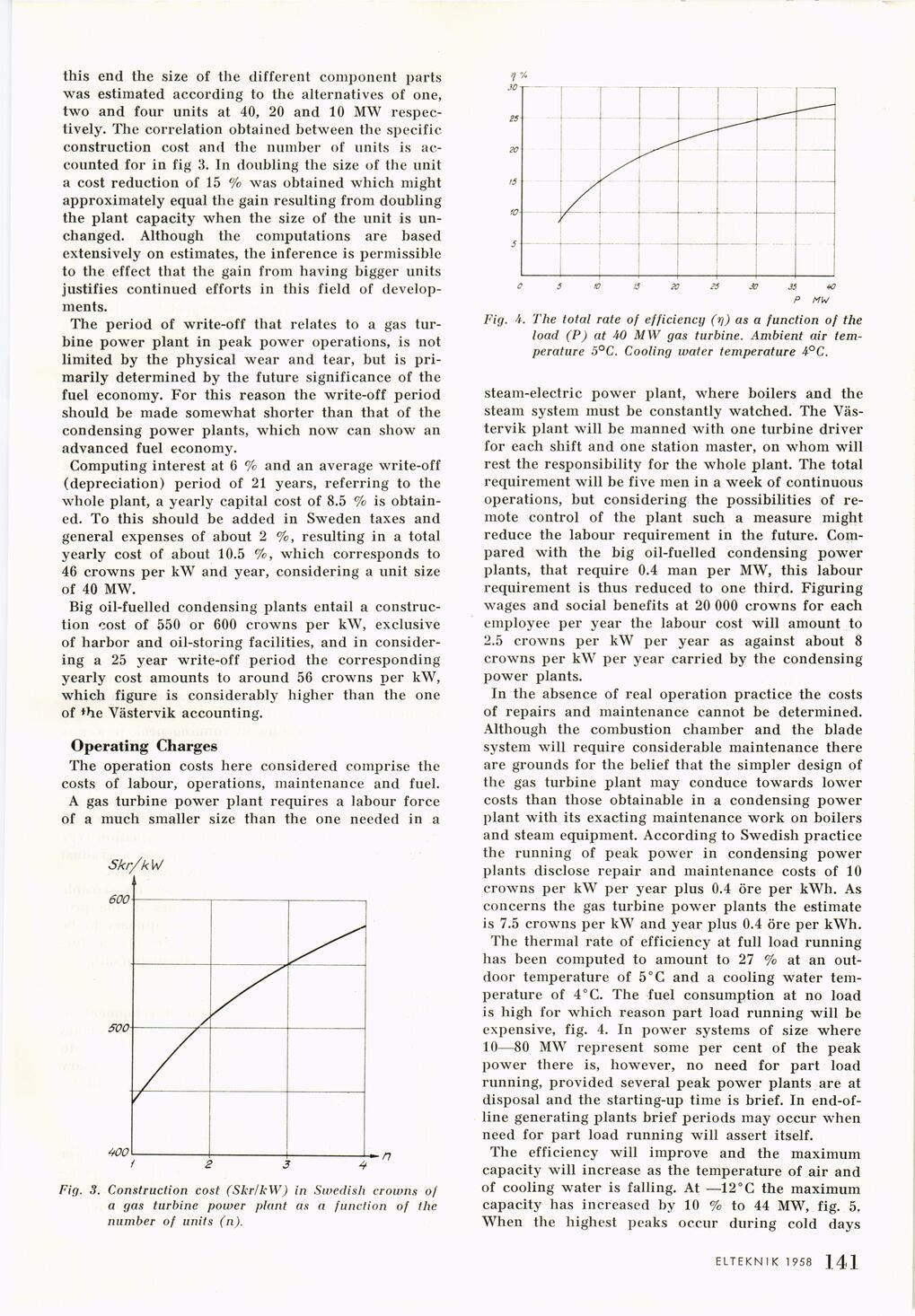
Full resolution (JPEG) - On this page / på denna sida - 1958, H. 10 - Power Generation by Large Gas Turbine Units, by Lars E Lingstrand and Jan R Schnittger

<< prev. page << föreg. sida << >> nästa sida >> next page >>
Below is the raw OCR text
from the above scanned image.
Do you see an error? Proofread the page now!
Här nedan syns maskintolkade texten från faksimilbilden ovan.
Ser du något fel? Korrekturläs sidan nu!
This page has never been proofread. / Denna sida har aldrig korrekturlästs.
this end the size of the different component parts
was estimated according to the alternatives of one,
two and four units at 40, 20 and 10 MW
respectively. The correlation obtained between the specific
construction cost and the number of units is
accounted for in fig 3. In doubling the size of the unit
a cost reduction of 15 % was obtained which might
approximately equal the gain resulting from doubling
the plant capacity when the size of the unit is
unchanged. Although the computations are based
extensively on estimates, the inference is permissible
to the effect that the gain from having bigger units
justifies continued efforts in this field of
developments.
The period of write-off that relates to a gas
turbine power plant in peak power operations, is not
limited by the physical wear and tear, but is
primarily determined by the future significance of the
fuel economy. For this reason the write-off period
should be made somewhat shorter than that of the
condensing power plants, which now can show an
advanced fuel economy.
Computing interest at 6 % and an average write-off
(depreciation) period of 21 years, referring to the
whole plant, a yearly capital cost of 8.5 % is
obtained. To this should be added in Sweden taxes and
general expenses of about 2 %, resulting in a total
yearly cost of about 10.5 %, which corresponds to
46 crowns per kW and year, considering a unit size
of 40 MW.
Big oil-fuelled condensing plants entail a
construction cost of 550 or 600 crowns per kW, exclusive
of harbor and oil-storing facilities, and in
considering a 25 year write-off period the corresponding
yearly cost amounts to around 56 crowns per kW,
which figure is considerably higher than the one
of »he Västervik accounting.
Operating Charges
The operation costs here considered comprise the
costs of labour, operations, maintenance and fuel.
A gas turbine power plant requires a labour force
of a much smaller size than the one needed in a
WO
Fig. 3. Construction cost (Skr/kW) in Swedish crowns of
a gas turbine power plant as a function of the
number of units (n).
P MW
Fig. 4. The total rate of efficiency (r/) as a function of the
load (P) at 40 MW gas turbine. Ambient air
temperature 5°C. Cooling water temperature 4°C.
steam-electric power plant, where boilers and the
steam system must be constantly watched. The
Västervik plant will be manned with one turbine driver
for each shift and one station master, on whom will
rest the responsibility for the whole plant. The total
requirement will be five men in a week of continuous
operations, but considering the possibilities of
remote control of the plant such a measure might
reduce the labour requirement in the future.
Compared with the big oil-fuelled condensing power
plants, that require 0.4 man per MW, this labour
requirement is thus reduced to one third. Figuring
wages and social benefits at 20 000 crowns for each
employee per year the labour cost will amount to
2.5 crowns per kW per year as against about 8
crowns per kW per year carried by the condensing
power plants.
In the absence of real operation practice the costs
of repairs and maintenance cannot be determined.
Although the combustion chamber and the blade
system will require considerable maintenance there
are grounds for the belief that the simpler design of
the gas turbine plant may conduce towards lower
costs than those obtainable in a condensing power
plant with its exacting maintenance work on boilers
and steam equipment. According to Swedish practice
the running of peak power in condensing power
plants disclose repair and maintenance costs of 10
crowns per kW per year plus 0.4 ore per kWh. As
concerns the gas turbine power plants the estimate
is 7.5 crowns per kW and year plus 0.4 ore per kWh.
The thermal rate of efficiency at full load running
has been computed to amount to 27 % at an
outdoor temperature of 5°C and a cooling water
temperature of 4°C. The fuel consumption at no load
is high for which reason part load running will be
expensive, fig. 4. In power systems of size where
10—80 MW represent some per cent of the peak
power there is, however, no need for part load
running, provided several peak power plants are at
disposal and the starting-up time is brief. In
end-of-line generating plants brief periods may occur when
need for part load running will assert itself.
The efficiency will improve and the maximum
capacity will increase as the temperature of air and
of cooling water is falling. At —12°C the maximum
capacity has increased by 10 % to 44 MW, fig. 5.
When the highest peaks occur during cold days
%
ELTEKNIK 1958 1 1 9
<< prev. page << föreg. sida << >> nästa sida >> next page >>